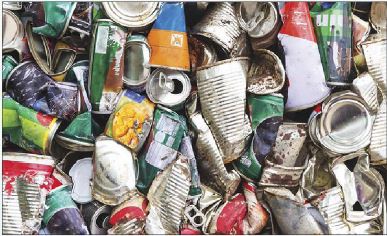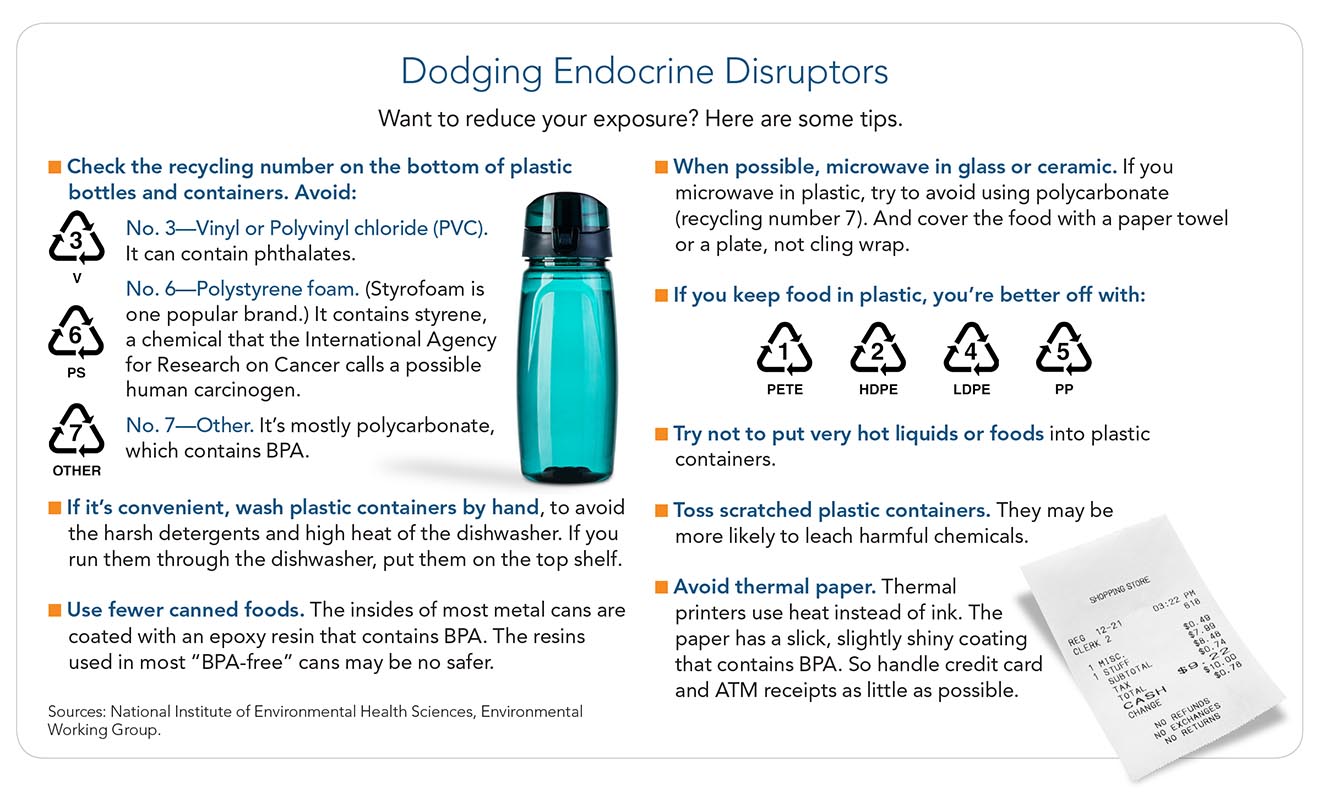Kicking the can

When food containers become part of your meal
Endocrine disruptors are chemicals that can interfere with estrogen, testosterone, thyroid hormone, insulin, or other hormones. At very low levels, they can turn on, shut off, or alter the signals that the hormones send throughout our bodies. And that can spell trouble.
While we’re most vulnerable to endocrine disruptors in the womb or in infancy, “no matter what your age, you have to be concerned any time you may be interfering with a hormone,” says Heather Patisaul, a professor of biology at North Carolina State University.
“When we talk about estrogen, for example, we usually think about reproductive health. But estrogen does a lot of other important things, such as keeping the heart, brain, and bones healthy.”
And for people who have—or have a higher risk of—hormone-sensitive cancers, like breast or prostate, adds Patisaul, “you certainly don’t want a chemical in your body that’s mimicking or interfering with hormone activity.”
Endocrine-disrupting chemicals can end up in what we eat and drink because they’re used in food processing equipment and food packaging.
Here’s what we know about three key disruptors and how to avoid them.
Perchlorate
Perchlorate is pretty much all around us, so everybody has it in their urine,” says Maricel Maffini, a toxicologist formerly with the Natural Resources Defense Council. “But we’d all be better off not being exposed to it.”
Why? Perchlorate can block the thyroid gland from taking up iodine, which it needs to make thyroid hormone.
“The hormone is essential for fetal and infant brain development, as well as for normal metabolism in people of all ages,” explains Maffini.1 “If you’re not making enough thyroid hormone, any amount of perchlorate is a problem.”
Perchlorate can occur naturally in soil. It’s also manufactured for use in rocket fuel and explosives and to reduce static in carpets, electronic equipment, and, since 2005, plastic materials used to transport and store dry food ingredients.
The iodine in milk and yogurt can help head off perchlorate's damage.
“The Food and Drug Administration apparently didn’t realize at the time how much perchlorate food can pick up as it rubs against the plastic,” says Maffini. According to the FDA, infants are consuming 34 percent more—and toddlers 23 percent more—perchlorate than they did in 2005.2
“Children eat more of the kinds of foods, like rice and oats, that come into contact with perchlorate-containing plastic,” notes Maffini.
The FDA finds small amounts of perchlorate in virtually every category of food it tests. In 2014, a coalition of nine consumer groups (including the Center for Science in the Public Interest, Nutrition Action‘s publisher) urged the FDA to ban perchlorate in materials that come into contact with food. Last spring, the agency denied the petition, largely on technicalities. The groups have appealed.3
You can’t really avoid perchlorate, but you can counter it by getting enough iodine. That means using iodized salt, eating iodine-rich foods (like milk, yogurt, and seafood), or taking a daily supplement with 150 micrograms of iodine (the amount in many multis).
“Iodine is especially important for women who are pregnant or breastfeeding,” says Maffini. (Talk to your doctor about your iodine intake if you’re taking ACE inhibitors, diuretics, or anti-thyroid medications.)
1Curr. Environ. Health Rep. 3: 107, 2016.
2J. Expo. Sci. Environ. Epidemiol. 2016. doi:10.1038/jes.2016.78.
3cspinet.org/news/fda-denies-petition-protect-consumersperchlorate-20170503.
BPA
Bisphenol A is everywhere. It’s used to make polycarbonate, a hard plastic, and to protect the insides of cans, jar lids, and bottle caps. It also coats printed receipts from cash registers, gas pumps, and ATMs.
So it’s no surprise that nearly all of us have BPA in our bodies.
Researchers report that tiny amounts of BPA cause subtle changes in fetal and newborn lab animals.
“If these kinds of changes occur in human infants, they might increase the risk of birth defects or infertility and cancer later in life,” says NC State biology professor Heather Patisaul.
Mothers with high levels of BPA in their urine during pregnancy, notes Patisaul, have children who are more likely to suffer from behavioral problems than the children of mothers with lower levels.1
Like most research on humans and BPA, that kind of study can’t prove cause and effect, but it’s troubling nevertheless.
Adults
Is BPA harmful to adults? It’s not clear. “But there are certainly hints in the research,” says Patisaul.
Some of the evidence:
Obesity. Researchers monitored the weight of nearly 1,000 nurses after they provided urine samples for BPA testing. After 10 years, the women who entered the study with the highest BPA levels gained an average of five pounds more than those with the lowest levels.2
Type 2 diabetes. Giving BPA to grown animals leads to greater insulin resistance in some studies.3 (Insulin allows blood sugar to enter cells. If your cells become resistant to insulin, you have an increased risk of type 2 diabetes and heart disease.)
What about humans?
Middle-aged U.S. nurses who had the highest levels of BPA in their urine were twice as likely to later be diagnosed with type 2 diabetes as nurses with the lowest BPA levels.4
However, that wasn’t true for nurses in their 60s and 70s. “The younger women, who have not experienced menopause, may be more vulnerable to endocrine disruptors than older, postmenopausal women,” says Qi Sun, an assistant professor in the department of nutrition at the Harvard T.H. Chan School of Public Health.
Heart disease. In an 11-year study of nearly 1,500 people in the UK, those with higher BPA levels in their urine at the start were 11 percent more likely to later be diagnosed with heart disease than those with lower levels.5 But the increased risk wasn’t quite statistically significant, so it could have been due to chance.
Cancer. “It is clear that BPA can act as an estrogenic compound,” says Ruth Keri, a cancer researcher at Case Western Reserve University. “So it is conceivable that BPA may promote the growth of any tumors that are driven by estrogens, such as breast cancers.”
Exposing mice to BPA in the womb leads to an increase in breast tumors.6
“But there is much less research on exposure in humans and the impact that it can have on cancer susceptibility or growth,” notes Keri.

BPA is in many can linings. BPA substitutes may be no safer.
Culture Clash
Despite the emerging evidence suggesting that BPA may be harmful, the Food and Drug Administration has ruled that it’s safe.
“Governments rely on classic toxicology studies that are good at looking for gross signs of illness, such as organ failure,” says Patisaul.
“But a lot of scientists believe that many of those studies are out of date because they don’t look for subtle effects that could contribute to chronic disease.”
For example, a classic way to look for harm to an animal’s brain is to weigh it. “That’s pretty crude,” Patisaul points out. “Your brain has to be really sick to change weight.”
Instead, she and others count the number of estrogen receptors in the brain, which drops when animals are exposed to BPA in the womb and at a young age.7
“I think it makes the brain more vulnerable to hormone-dependent changes that can affect behavior and mood, so I worry about it,” says Patisaul. “But the FDA doesn’t consider those changes a reason for restricting or banning BPA at the levels of current human exposure.”
Reducing Exposure
To minimize your exposure to BPA, avoid foods and beverages in cans.
“BPA-free” cans and plastics may not be a get-out-of-jail-free card, though. Some researchers suspect that BPA substitutes may not be safe, either.
1 NeuroToxicology 49: 174, 2015.
2 Int. J. Obes. 38: 1532, 2014.
4 Environ. Health Perspect. 122: 616, 2014.
5 Circulation 125: 1482, 2012.
6 Biol. Reprod. 85: 490, 2011.
7 Toxicol. Sci. 140: 190, 2014.
Phthalates
"Chemical in macaroni and cheese tied to birth defects,” announced the foxnews.com headline in July.
What was behind that bombshell? When consumer groups tested 30 cheese products, including boxed macaroni and cheese, for traces of a family of chemical plasticizers called phthalates, all but one of the 30 tested positive.1
Among other things, phthalates are linked to birth defects in boys.
Phthalates (THAL-ates) increase the flexibility of plastics in everything from vinyl flooring and shower curtains to IV tubes, food processing equipment, and food packaging. They’re also used in some adhesives, detergents, shampoos, and nail polishes.
“Phthalates are everywhere, and virtually all Americans have traces of these chemicals in their bodies,” says Ami Zota, a professor of environmental and occupational health at George Washington University. “You can even find them in household dust.”
The young may be the most vulnerable. In one study, seven-year-olds whose mothers had the highest levels of phthalates in their urine during pregnancy had IQs that averaged seven points lower than the IQs of seven- year-olds whose mothers had the lowest phthalate levels.2
Like most human research on phthalates, that kind of study can’t prove that the chemicals caused the lower IQs. But researchers can’t exactly expose people to phthalates or a placebo for years to see what harm they might do.
Adults
Phthalates may also put adults at risk. “Researchers are finding that exposure to phthalates in adulthood may be linked to diabetes, obesity, and the metabolic syndrome,” notes Zota.
In the National Health and Nutrition Examination Survey, people with higher levels of certain phthalates weighed more and had larger waists and higher blood sugar and insulin levels than those with lower levels.3,4
But those studies were snapshots in time. They couldn’t show whether higher phthalate levels increased blood sugar or weight or vice versa.
So researchers monitored nearly 1,000 nurses for 10 years after the women provided urine samples.
Those with the highest phthalate levels gained an average of one more pound every three years than those with the lowest levels.5 And middle-aged nurses with the highest phthalate levels were twice as likely to later be diagnosed with type 2 diabetes as those with the lowest levels.6
But there was no increase in diabetes risk for nurses in their 60s and 70s.
“We’re still trying to figure out why,” says Harvard’s Qi Sun. Older women may be less sensitive to phthalates because they have lower estrogen levels, he notes. “And endocrine disruptors exert their effects primarily through disturbing estrogen’s effects.”
Fertility
Some of the strongest evidence that phthalates cause harm: “Higher levels in mothers during pregnancy are linked to anatomical changes in infant boys that may affect their ability to father children later in life,” says Zota.7
What’s more, “phthalate exposure during adulthood is linked to decreased fertility, alterations in sperm, and decreased testosterone levels,” notes Sheela Sathyanarayana, an associate professor of pediatrics at the University of Washington.8
Females may be at risk, too. “We now have enough evidence from animal studies to show that exposure to phthalates during pregnancy harms the later reproductive health of the female offspring,” says Jodi Flaws, a professor of comparative biosciences at the University of Illinois.
Those studies used phthalate levels comparable to what humans are routinely exposed to.
“When the offspring are sexually mature, they have abnormal levels of sex steroid hormones, it will take them longer to get pregnant, they’re more likely to have complications during the pregnancy, and they produce smaller litters,” Flaws explains.9
Several studies suggest that phthalates can also affect fertility in women.
Harvard researchers measured the levels of 11 phthalates in the urine of 256 women undergoing in vitro fertilization. Those with the highest levels of six of the phthalates produced fewer eggs than those with the lowest levels. And women with the highest levels of one of the 11 phthalates were half as likely to become pregnant as those with the lowest levels.10
Other researchers analyzed 111 endocrine-disrupting chemicals in 31,575 women who were participating in the National Health and Nutrition Examination Survey from 1999 to 2008. Those with the highest levels of one particular phthalate reached menopause about four years earlier than the other women.11
An earlier menopause “could increase rates of infertility and lead to earlier development of cardiovascular disease, osteoporosis, and other medical problems,” the researchers noted.
Phthalates in Food
“Phthalates are commonly found in food, and avoiding them is really hard,” says Sathyanarayana.

Phthalates are found especially in meats, oils, and high-fat dairy foods, like cheese.
“We have some general ideas about which foods are more likely to be contaminated with them, such as poultry, red meat, butter, margarine, cooking oil, cream, and cheese. But we don’t know which specific oils, cheeses, or other foods to target.”
Making the challenge even harder: phthalates can leach into food from processing equipment and plastic packaging long before the food reaches us. And there’s no way we’d ever know.
When Sathyanarayana and her colleagues fed five families catered meals of local, fresh organic foods, they were stunned by the results.
Phthalate levels in the families’ urine were 33 times higher than levels in the urine of five similar families who ate their usual diets and were simply given advice about how to reduce phthalates.12
Two unexpected sources of phthalates in the special diet: coriander, which the caterer used liberally, and milk.
“We were not able to trace the sources of the contamination,” says Sathyanarayana. Odds are, it occurred before the food reached the caterer.
“We don’t know a lot about how our food is being contaminated with phthalates,” she points out. “The only way we can know that our food is free of phthalates is if the government does something about it.”
In 2016, a coalition of consumer and environmental groups (including CSPI) petitioned the FDA to ban phthalates in food packaging.13 The agency agreed to review the petition, but so far hasn’t declared what, if anything, it plans to do.
In the meantime, Sathyanarayana recommends eating more fresh foods.
“The more fresh it is, the less likely it is to be contaminated with phthalates, though that’s no guarantee.”

1 kleanupkraft.org/data-summary.pdf.
3 Int. J. Obes. 39: 994, 2015.
4 Environ. Health 13: 6, 2014.
5 Int. J. Obes. 38: 1532, 2014.
6 Environ. Health Perspect. 122: 616, 2014.
8 Hum. Reprod. 30: 2645, 2015.
9 Toxicol. Appl. Pharmacol. 318: 49, 2017.
10 Environ. Health Perspect. 124: 831, 2016.
11 PLoS One 10: e0116057, 2015.
12 J. Expo. Sci. Environ. Epidemiol. 23: 378, 2013.
13 blogs.edf.org/health/files/2016/04/Orthophthalates_ Food_Additive_Petition_3-18-16.pdf.

